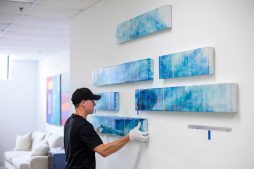According to the old saying, when one door closes, another one opens. Citizen Potawatomi Nation tribal member Tony Morton experienced this when Kasum Contemporary Fine Art in Oklahoma City shut its doors in November 2017. While the storefront was a steady staple in OKC’s ever-changing Plaza District, Morton and his co-owner and spouse Stacey Miller decided to pursue a somewhat different path.
However, Morton and Miller remain visible figures in the district. They live a short walk from their former gallery location on NW 16th Street. Morton said that although the storefront’s closure was somber in one sense, his business opportunities no longer required its existence.
Visitors frequented Kasum Contemporary during its Plaza District tenure. While the gallery’s art and installations were often priced higher than nearby spaces, Kasum became known for its focus on progressive contemporary art.
“Around the middle of last year, we decided that we would transition ourselves away from retail sales and into the service side of the industry. There are so few companies providing art services that we have been able to develop quickly,” Morton said.
As a result, more of the two owners’ time focused on generating revenue outside of the brick-and-mortar location.
“After four years of operation, we were able to grow our patronage substantially outside of the area, but it was still growing at a trickle locally,” he explained. “The vast majority of the sales that we were completing were being done during scheduled appointments, via phone or email in many cases.”
With a bit of humor, Morton added, “Staying open for 70 hours a week was providing a wonderful public service for Oklahoma City but huge burden for the business that wasn’t really benefiting from those open hours.”

As of now, Kasum Contemporary Fine Art offers two tracks of business. The first is art services.
The Peltier and Vieux descendant is always on the lookout for artists who are either starting out or in the midpoint of their careers. Kasum Contemporary Fine Art helps artists grow by managing non-creative aspects of studio business relative to operations, logistics, communications and marketing. Additional artist support services include evaluating client portfolios, conceptualizing marketing techniques and identifying opportunities to showcase each client’s work to the right audiences and at the right venues.
Kasum also specializes in logistics and exhibition planning for artists, museums and corporations. When it comes to staging, moving or maintaining a collection valued in the thousands or hundreds of thousands of dollars, Kasum’s expert care and knowledge ensure safe handling and proper display.
The second track of Kasum Contemporary Fine Art’s new direction is one in which Morton is very excited to expand upon. A specialty service he and Miller developed during their time as owners of the art gallery was that of a finder of art, and often times, large-scale art installations for clients wanting to decorate their homes or offices. Using those skills, Morton and Miller began working on substantial public and private art installation projects as well.
“Businesses have become more sophisticated in how they look at designing their offices and work spaces,” Morton explained. “It’s not just setting cubicles up and putting pictures on the wall. It’s about having an identity and providing an environment that employees and visitors want to be in.”
The increased focus in Oklahoma and the surrounding region on incorporating art in public spaces inspired Morton. Over the last decade, murals painted on buildings and large sculptures have become increasingly common. According to Morton, over the last two years, art screen wall projects — like those that wrap unsightly outdoor equipment like generators — contributed more than half a million dollars to Oklahoma City.
“Public art also applies to a great many things that people might not identify as art, but it’s art,” Morton explained.
He cited one of the city’s most visible symbols, the Skydance Bridge over Interstate 40, as a prime example.
“If you ask people what bridges they could remember driving under in Oklahoma City, it would be at the top of everyone’s list because it’s an artwork that creates a sense of place and reflects its community,” he said. “In order to make that possible, all the city did was allocate a small portion of the overall budget for artistic and design implementation on the project. It turns out it was worth substantially more than what they invested. The return on brand value and tourism alone made it completely worthwhile.”
Kasum now focuses on encouraging and consulting with interested private, nonprofit and municipal organizations on how to implement art and design in the manner which best befits the entities’ needs.
“A lot comes together to improve or make a great public space,” he said. “We work with whoever — a city, a neighborhood — to get these projects from inception to implementation and completion.”
Morton said the key to making such ventures successful includes fostering a collaborative spirit with all involved parties. Each project’s success depends on creating a place where people want to be. If the art does not reflect the community’s heritage and values, there is no audience to champion its continued existence.
“I’m looking for opportunities in the seven-state area where I may be able to find public opportunities to work with tribal nations on implementing the arts,” Morton said.
He’s hopeful the combination of art knowledge and design concepts, along with an awareness of the importance of tribal culture and heritage as a Citizen Potawatomi, can bear fruit.
Follow Tony Morton’s work at kasumcontemporary.com.
